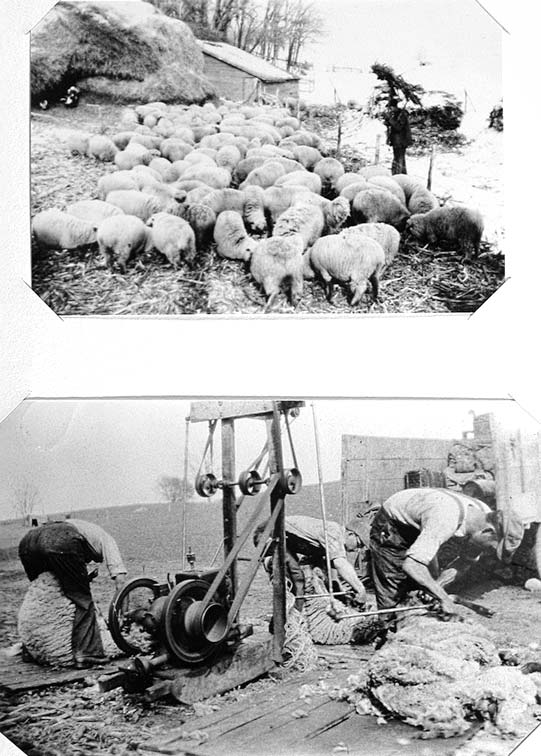Shearing Sheep
Top: Sheep pens with skunk family exiting straw shed.
Bottom: Shearing sheep (circa 1932).
Excerpt from Donald B. Johnson manuscript:
"One of the first things Pa built was a straw shed. A bunch of oak posts with crotches on the tops and poles across them again, plus some old wire netting and old planks and boards around the sides. We stacked the grain in the yard and blew the straw from the threshing machine onto the straw shed, which made a really warm shed for a few sows and heifers, etc. to winter in. [17.110-6]
"When first covered with new straw, it was really nice and the smell of the fresh straw made it a really cozy place. The coziness deteriorated fast during the winter, with all the manure, etc. and by spring the only good thing about it was that we could usually dig grub worms around it for sunfish bait. [17.111-1]
"All the glamour was gone in the hot summer when it was time to clean it. That was a hot, backbreaking job, forking out all the packed-down straw and manure from inside and around it into an old rickety manure spreader while swarms of flies buzzed around. We spread the manure and straw on the fields between the shocks right after the grain was cut, on the hottest days of the year, it always seemed. [17.111-2]
"The straw shed had lots of nooks and crannies up between the poles, etc. for the chickens, which were always outside in the summer, to make nests in. We didn't always find all the nests right away and sometimes we ate some eggs of questionable age and freshness. We called them 'straw shed eggs.' Ma couldn't stand to waste anything and always tried to convince me that the eggs were all right when I complained. I know I lost my taste for any kind of soft-cooked eggs. They weren't so noticeable if they were hard-boiled and mixed in with plenty of potatoes when you ate them."
"Raymond Skaar told about when they were 'batching' and he broke a rotten straw shed egg directly into the frying pan. He took the egg and pan and all clear out to the edge of the grove and, for all I know, the pan is still there." [17.111-3]
"Sheep were getting more numerous all over the country; everybody was getting them to help clear their land of brush (and berry bushes!). Sheep shearers were springing up all over, too. Carl Pearson was shearing with a gas-powered machine around Battle Lake and he wanted a new, improved model, so he traded us his used machine for the muskrat-trapping rights that spring on my grandmother's lakeshore.... When I tried the machine (luckily a while before the shearing season), I found a small, but important, part missing. I always figured that was a 'put up deal,' but I got the parts catalog and got the piece that was missing. I always wondered if he wondered how I got it to work. [26.169-4]
"The first year I made enough with the old machine to buy the new, improved, latest model of sheep shearing machine, too, and was shearing sheep in a big area. Some farms had electricity and some didn't yet, so we mounted [a wash] machine [engine] on a board and had a gas engine on one end and an electric motor on the other end and could put the belt on either one. [26.170-1]
"Shearing sheep is the hardest work I have ever done. It uses every muscle you have and if you work in a cool place or in a draft, you get stiff and if it is in a closed area, the ammonia fumes from the sheep are terrible. My record for one day was 130 from 12 noon until 11 p.m. on a hot, June day, shearing outside. After we hung up lights to shear by, the bugs almost ate us alive." [26.170-2]
Previous • Next • Contents • About • Sitemap • Home
